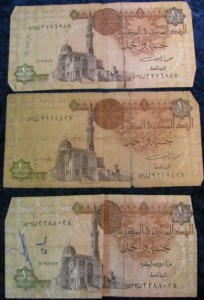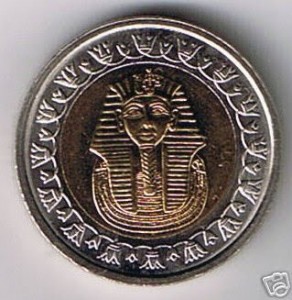Egyptian Pound
Short Facts About the EGP – Egyptian Pound
![]()
Choose what you want to read about in our extensive guide to Egyptian Pound:
- Common names for Egyptian Pound (EGP)
- Countries with Egyptian Pound
- Unofficial countries with Egyptian Pound
- History of the Commonwealth currency
- How much is traded for EGP?
- Currency symbol and ISO code
- Currency crisis with Egyptian Pound
- Central Bank of Egypt (CBE)
- Trade Egyptian Pound
- EGP Exchange Rate
- EGP vs other currencies
- Pictures of Egyptian Pound, notes
The Egyptian pound, also referred to as the EGP in foreign exchange, is the official currency of the Arab Republic of Egypt, commonly known as Egypt. The Egyptian pound is sub-divided into 100 piastras, which is also equal to 1000 milliemes.
Common Names for EGP
The Egyptian pound is usually referred to by locals as the gineih, while the piastra is called the girsh.
Countries with EGP
Egypt is officially the only country that uses the Egyptian pound as the main currency, although the pound is also used as a currency unit in some other countries such as:
1. United Kingdom – Pound sterling
2. Lebanon – Lebanese pound
3. Syria – Syrian pound
4. Sudan – Sudanese pound
Unofficial EGP Countries
Along with the Israeli sheqel, the Egyptian pound is also used, though unofficially, by residents of the Gaza Strip, one of the occupied Palestinian territories that shares the border with Egypt on the southwest and with Israel on the east and north.
How much is the EGP Traded?
At present, the Egyptian pound is not among the 15 most-traded currencies in the world. This can be attributed to the unstable political setting in Egypt since President Hosni Mubarak was removed from power by a people’s revolt.
Currency Symbol and ISO Code
The ISO code for the Egyptian pound is EGP and the currency symbol is £, although the symbols E£ and £E are also used in rare instances. However, the Egyptian locals usually use the symbol LE, basically an acronym for the French term “livre egyptienne”, which literally translates to “Egyptian pound”.
Currency Crisis with EGP
Since the forced resignation of President Hosni Mubarak, the unstable climate in Egypt’s political arena has resulted in capital flight and has kept potential investors and tourists away, and with Egypt’s reserves, including gold, already dwindling as a result of the Egyptian government’s effort to defend the value of the Egyptian pound, analysts predict that, unless Egypt’s political climate stabilises, a currency crisis will be looming.
Central Bank for EGP
Formed in 1961 as a result of the merger between the Central Bank of Egypt and the National Bank of Egypt, the Central Bank of Egypt is currently the sole monetary authority in the Arab Republic of Egypt with the following functions:
1. Regulate the Egypt’s banking system and banks
2. Formulate and implement Egypt’s banking, monetary and credit policies
3. Issue banknotes
4. Oversee and manage Egypt’s foreign currency and gold reserves
5. Manage Egypt’s external and internal debt
6. Manage Egypt’s foreign exchange activities
7. Manage Egypt’s national payment system
Trade EGP
For the past ten years, the average currency rankings have shown that the most active Egyptian pound exchange is with the Euro.
History of the EGP
Prior to 1834 when Egypt had no official currency, locally minted gold and silver coins were primarily used for exchange.
Moving forward to 1836, the first minted Egyptian pound, known as the gineih, came into circulation after the Egyptian government’s issuance of a decree that provided the introduction of an official currency based on the bimetallic standard of silver and gold.
In 1898, the National Bank of Egypt was created and was granted the authority to issue Egyptian pound banknotes which were convertible to gold. However, a new law that was passed in 1914 suspended the conversion of the banknotes into gold, making the Egyptian pound banknote a legal tender. Furthermore, it was only in the early parts of 1968 that metallic threads, an anti-counterfeiting feature, were used on the Egyptian banknotes.
EGP vs other currencies
Despite the political instability and civil unrest currently hounding Egypt, the Egyptian pound still remains a relatively strong performer against major currencies such as the Euro, the United States Dollar, Swiss Franc, Japanese Yen, Pound Sterling, Australian Dollar and Canadian Dollar. This strong performance can be attributed to Egypt’s foreign exchange and gold reserves, although experts and analysts are having reservations on how long the reserves will be able to sustain the Egyptian pound’s strong performance under the prevailing conditions.
Pictures of EGP notes and coins
Circulated in denominations of 1, 5, 10, 20, 50, 100 and 200, Egyptian pound banknotes have Arabic texts and numbers at the front and English texts and numbers at the back. Moreover, piastra banknotes are also circulated, though rarely, in denominations of 25 and 50.
Likewise, piastra coins are minted in denominations of 5, 10, 20, 25 and 50. In addition, 1-pound Egyptian coins, usually made from a combination of nickel, steel and copper, are also circulated.
Below are some photos of banknotes and coins currently used in Egypt:







